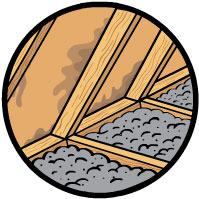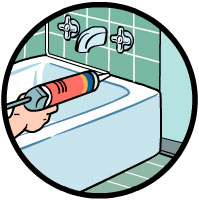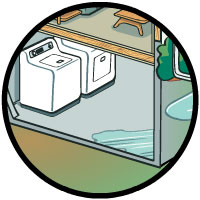 Attic
Attic
Drip Alert: Because the attic is not accessed regularly, homeowners often fail to realize it when they have a growing moisture and mold problem in their attic. Many of these stem from improperly ventilated dryers and fans. Be sure to check your attic regularly.
-
If it’s rusty and musty, you might have a host of moisture problems to contend with. Look for water stains on the underside of the roof, rusted nails, and discolored or mildewed sections on any surface. Call in expert advice if the situation appears severe.
-
Minor surface mildew can be wiped away using a chlorine-and-water solution. Be sure to dry the surface after you've finished. Painting over a mildew problem is unlikely to check the growth of the mildew.
-
Check that there is room for air to flow from the eaves (soffit vents) into the attic space and out the upper roof vents. Insulation should not block airflow by being pressed tight to the roof sheathing at the eaves or covering the eave or soffit vents. Attic baffles can be purchased at lumberyards to allow airflow.
-
Take time to inspect the amount of insulation in your attic. If you can see the wood framing between rows of insulation, as shown in the above image, you probably need more insulation.
-
Inspect bathroom, kitchen, and other exhaust ducts for leaks and blockages.
 Ventilation
Ventilation
Drip Alert: Many people falsely assume that venting dryers inside the house saves money by adding warm air in the house, rather than outside. What people fail to realize is that this is moist air, and it costs much more to repair parts of the house damaged by the mold that grows from improper ventilation than the money they save in heating bills from venting indoors. Be sure your vents lead to the outdoors and never into the attic or another part of the house.
-
Inspect bathroom, kitchen, and other exhaust ducts for leaks and blockages.
-
Install timers on bathroom and laundry fans, and run fans for 20 minutes after showers.
-
Use an approved aerosol foam sealant to seal around any ceiling penetrations that may allow moist air to flow into the attic space.
-
Place foam rubber insulation gaskets around attic space access panels.
-
When inspecting your attic space, ensure that your soffit (under eave) vents are not blocked by the attic insulation. Cardboard air dams can be placed within the attic to prevent this from happening or to facilitate the opening up of blocked vents.
 Kitchen/Bath
Kitchen/Bath
A Dry Idea: Run your kitchen's exhaust fan while using the dishwasher, cooking, or otherwise creating moisture, and leave it running for 20 minutes after use. Do the same for your bathroom or laundry room fans. This vents any residual moisture in the air.
-
Replace discolored, cracked, or worn caulk around plumbing fixtures, paying close attention to the tub/shower enclosure.
-
Remove all old caulk using chemical caulk remover, putty knife, or other blunt-end, thin tool. Never apply fresh caulk over older caulk. Wipe away any soap scum.
-
Fill the tub or sink with water. The weight will stretch the gap between the fixture and the wall.
-
Using a caulk gun held at 45 degrees, push the bead ahead of the nozzle.
-
Use a spoon dipped in soapy water to apply a smooth finish before the caulk cures.
-
Check the grout around wall and floor tiles, especially in tiled showers. Replace as needed.
-
Use tile and marble sealers annually or as recommended by manufacturers.
 Basement
Basement
A Dry Idea: In highly humid climates with a lot of moisture buildup, consider installing a heat recovery ventilator. These devices provide a controlled air exchange to prevent moist air accumulation.
-
Musty odors indicate a moisture problem. Check for discoloration on walls, floors, and ceilings, and take immediate action.
-
One method to determine if moisture is seeping through the slab is to tape a square piece of plastic wrap to your basement floor. If moisture beads up underneath, you have water getting through the slab. Call a professional for advice.
-
Keep dehumidifiers empty.
-
When finishing basements, seek expert advice before installing insulation, vapor retarders, or drywall against exterior concrete walls.
-
Inspect crawlspaces annually. Be sure to clean out crawlspace vents.
-
Check for moisture-related problems – signs of standing water, mildew on floor joists, signs of rust on metal fasteners, etc.
-
Check underfloor insulation. Replace any loose batts.
-
If it’s not present, install a 6-mil polyethylene vapor barrier on the ground.